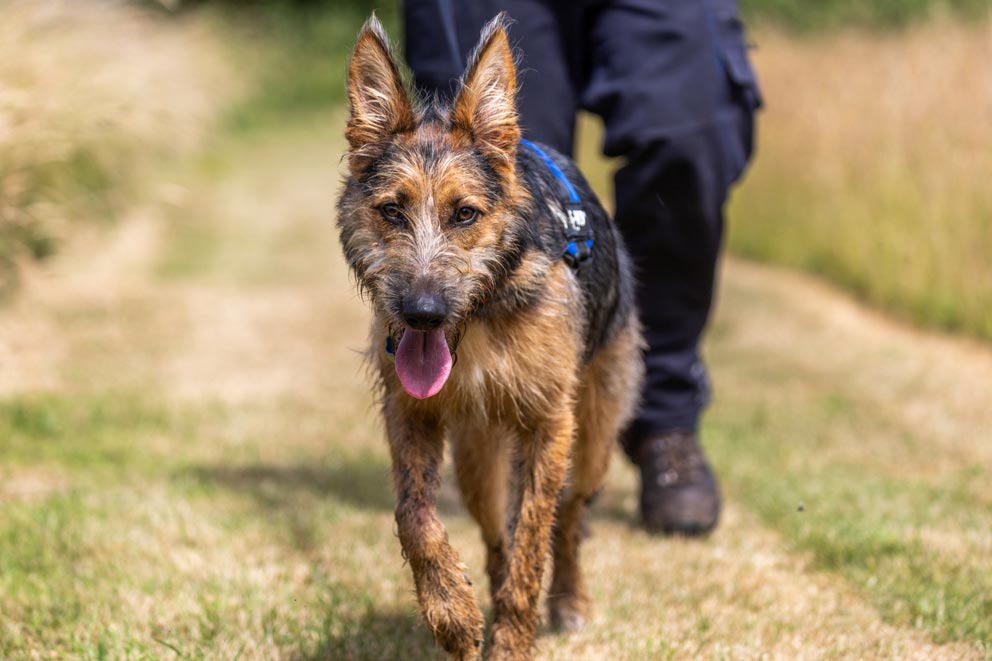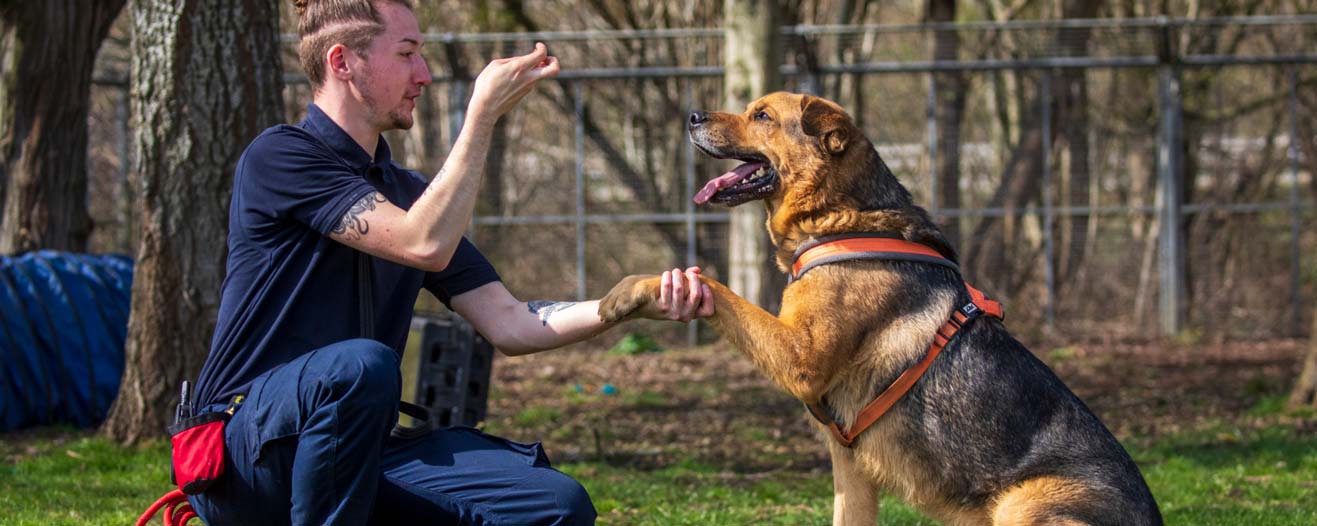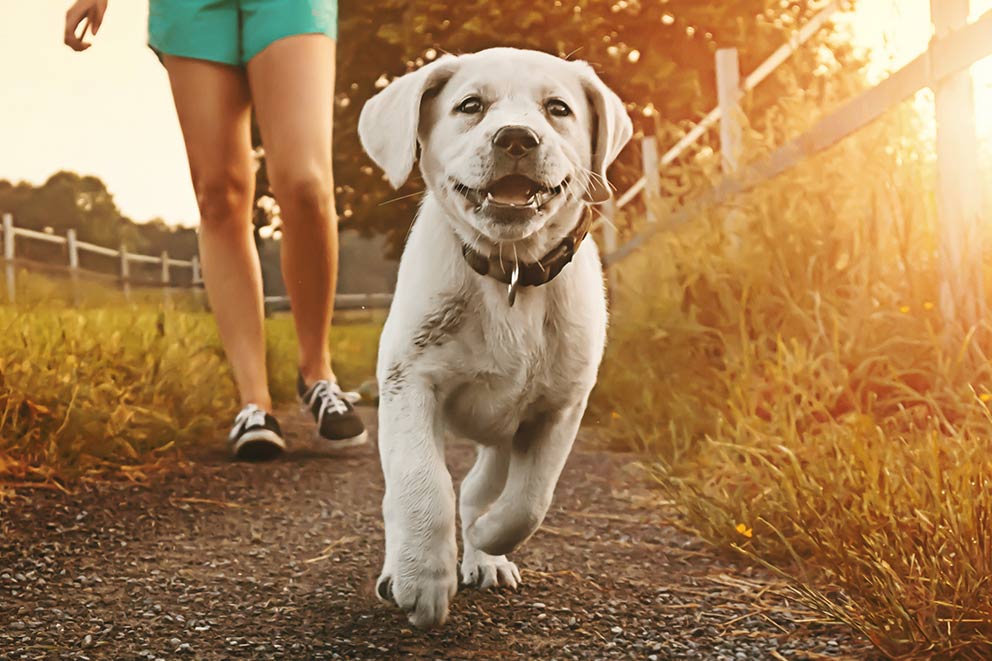How to walk your dog safely and responsibly
Taking your dog out for a walk is essential for their physical and mental wellbeing. The word “walkies!” is magic to dogs, but to nearby wildlife and the local countryside, it can be a cause for concern.
Learn how to keep yourself, your dog, other animals, and the countryside safe with our guide on responsible dog walking etiquette.

Jump to:
What is dog walking etiquette?
Dog walking etiquette covers the basic behaviours you would expect of dog walkers when out in a community space or countryside, with other dogs, farmed animals and wildlife around.
Here are our top dog walking tips to keep you and your dog safe, while respecting your surroundings:
Do:
- Make sure your dog is microchipped: It’s a legal requirement to microchip dogs over the age of eight weeks old.
- Clean up after your dog: Pick up poo and throw it away in a dog bin. It is an offence to leave it behind, as dog poo can cause infections and disease in other animals.
- Clean up any dog-related litter: Poo bags and treat packaging, for example, can harm wildlife and farmed animals, as they may try to eat it. There are many types of litter that can harm animals. If there are no bins nearby, take the litter home with you to dispose of.
- Pay attention to your dog: Keep them within sight at all times to prevent them running off and chasing wildlife. It’s also important to look for signs of distress or discomfort, or anything nearby that might have caught their attention (bugs, plants, other animals, other people). Signs they’re stressed can include licking their lips and a low tail slowly wagging.
- Ensure you and your dog are visible in the dark: A reflective collar or coat can help drivers, wildlife or other dog walkers see you when out walking in the dark countryside.
- Keep your dog on the lead (especially if they don’t have a solid recall): We always recommend keeping your dog on the lead around farmed animals to prevent accidents or injury. If you see another dog on a lead, ensure yours is, too. Find out more below about Open Access Land and legal requirements for dogs and leads.
- Follow the countryside code: This includes remaining on marked paths, keeping your dog under control, and caring for nature.
Don't:
- Don't take your dog out if they don’t have a collar with ID: It’s a legal requirement for your dog to have a collar with an ID tag when out in public spaces.
- Don't walk your dog during the hottest hours of the day in summer: This can lead to heatstroke in dogs, which can be fatal if left untreated (find out how to care for dogs in hot weather). Flat-faced (brachycephalic) dogs are particularly at risk in hot weather due to their inability to regulate their body temperature through panting (learn how to care for them).
- Don't let your dog eat things you’re unsure about: There are many poisonous plants and seasonal poisons that are dangerous for your dog to ingest. From acorns to fungi to rock salt, make sure your dog isn’t eating anything you’re unsure about. Learn more about the most common dog poisons. You can also teach your dog the 'drop it' command, so you can safely and effectively remove anything they have picked up
- Don’t stray from marked footpaths: Remaining on marked paths stops your dog from straying and startling wildlife, or running through crops and plants that can be damaged by trampling. However, Open Access Land has different rules – dogs must be on leads at all times if farmed animals are around, and always during March and July to protect ground nesting birds. Find out more below.
Keeping your dog on the lead
To ensure the complete safety of your dog, wildlife, farmed animals, the countryside and the public, we highly recommend keeping your dog on the lead at all times, unless you are 100% certain no other nearby animals, plants or people are going to be affected or disturbed.
What are the dog walking laws in the UK?
Livestock worrying
The Dogs (Protection of Livestock) Act 1953 states that it’s an offence for your dog to chase, worry or attack livestock – as a result, you could face a fine of up to £1000.
The Countryside Code states that, on Open Access land and at the coast, you are legally required to put your dog on a lead around livestock. Between March 1st and July 31st, you are legally required to put your dog on a lead on Open Access land, even if there is no livestock on the land, to protect ground nesting birds.
Again, we will always advise that you keep your dog’s lead on at all times when around livestock or wildlife (even in circumstances when it's not legally required), to ensure the safety of all animals and reduce the risk of an accident.
Dog fouling
The Environmental Protection Act (1990), Litter (Animal Droppings) Order 1991, Anti-social Behaviour, Crime and Policing Act 2014, and The Countryside Code state that you must pick up all dog poo when in public places. Dog faeces can contain parasites that can seriously harm farmed animals and wildlife. If there are no bins available, take the poo bags home to dispose of them. If you don’t pick up after your dog, you can face a fixed penalty notice of up to £100, or a £1000 fine.
Dogs on leads
While there’s no law requiring you to keep your dog on a lead in public spaces, certain public areas in England and Wales are covered by the Public Spaces Protection Orders (PSPOs). In these places, you may be required to keep your dog on a lead, stop your dog entering certain places, or carry a poop scoop and disposable bags, as well as other things. If you ignore a PSPO, you can be fined a fixed penalty notice of up to £100, or £1000 if it goes to court.
Out of control or dangerous dogs
The Dangerous Dogs Act 1991 states that dogs must not be 'dangerously out of control’. This includes injuring a person, making somebody fearful of being injured, or injuring an assistance dog. You can prevent this from happening by training your dog to be around others safely. If your dog does hurt another person, you could face prison time, an unlimited fine, and your dog may also be humanely put down.
Walking dogs on a road
The Highway Code suggests that dogs should not be let out on the road on their own – they should be kept on a short lead when walking on the pavement, road or path shared with cyclists or horse riders.
What if an animal chases me and my dog?
If you need to walk through a field with farmed animals and are concerned about being chased, keep your dog on a short lead, give animals plenty of space and never walk between animals and their young. If you are chased or feel threatened, the safest thing to do is let your dog off the lead so they can run away and exit the field calmly and quickly, taking the closest route out.
Protect your dog against ticks, fleas, disease and potential poisons
Dogs can pick up ticks, fleas or diseases like Alabama rot when out on a walk, as well as encountering potential poisons. But the more you know about these risks, the better you’ll be able to recognise, treat and protect your dog against them.
- Ticks: Ticks are common in woodland and grassland and, although active throughout the year, you'll most likely see them between spring and autumn. They affect dogs more often than cats. Learn how to identify and remove them.
- Fleas: Fleas can be a problem even in the most spotless home or on the cleanest pet. Here's how to spot signs of fleas and how to treat your pet – and your home – to keep fleas away.
- Alabama rot: Alabama rot is a disease that affects dogs, often picked up when walking dogs in the countryside – though it is incredibly rare. Learn how to spot the symptoms, and what to do if you think your dog might have Alabama rot.
- Potential poisons: Dogs can be poisoned by things that are harmless to humans. Find a list of common dog poisons, and what to do if you think your dog has eaten something poisonous, on our dog poisoning page.




